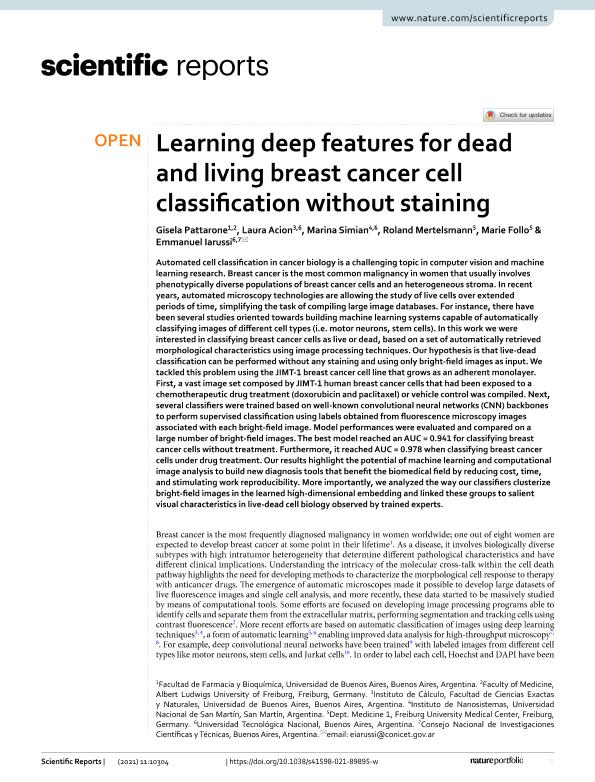Mostrar el registro sencillo del ítem
dc.contributor.author
Pattarone, Gisela
dc.contributor.author
Acion, Laura

dc.contributor.author
Simian, Marina

dc.contributor.author
Mertelsmann, Roland

dc.contributor.author
Follo, Marie
dc.contributor.author
Iarussi, Emmanuel

dc.date.available
2022-05-16T15:10:25Z
dc.date.issued
2021-05
dc.identifier.citation
Pattarone, Gisela; Acion, Laura; Simian, Marina; Mertelsmann, Roland; Follo, Marie; et al.; Learning deep features for dead and living breast cancer cell classification without staining; Springer Nature; Scientific Reports; 11; 5-2021; 1-10
dc.identifier.issn
2045-2322
dc.identifier.uri
http://hdl.handle.net/11336/157601
dc.description.abstract
Automated cell classification in cancer biology is a challenging topic in computer vision and machine learning research. Breast cancer is the most common malignancy in women that usually involves phenotypically diverse populations of breast cancer cells and an heterogeneous stroma. In recent years, automated microscopy technologies are allowing the study of live cells over extended periods of time, simplifying the task of compiling large image databases. For instance, there have been several studies oriented towards building machine learning systems capable of automatically classifying images of different cell types (i.e. motor neurons, stem cells). In this work we were interested in classifying breast cancer cells as live or dead, based on a set of automatically retrieved morphological characteristics using image processing techniques. Our hypothesis is that live-dead classification can be performed without any staining and using only bright-field images as input. We tackled this problem using the JIMT-1 breast cancer cell line that grows as an adherent monolayer. First, a vast image set composed by JIMT-1 human breast cancer cells that had been exposed to a chemotherapeutic drug treatment (doxorubicin and paclitaxel) or vehicle control was compiled. Next, several classifiers were trained based on well-known convolutional neural networks (CNN) backbones to perform supervised classification using labels obtained from fluorescence microscopy images associated with each bright-field image. Model performances were evaluated and compared on a large number of bright-field images. The best model reached an AUC = 0.941 for classifying breast cancer cells without treatment. Furthermore, it reached AUC = 0.978 when classifying breast cancer cells under drug treatment. Our results highlight the potential of machine learning and computational image analysis to build new diagnosis tools that benefit the biomedical field by reducing cost, time, and stimulating work reproducibility. More importantly, we analyzed the way our classifiers clusterize bright-field images in the learned high-dimensional embedding and linked these groups to salient visual characteristics in live-dead cell biology observed by trained experts.
dc.format
application/pdf
dc.language.iso
eng
dc.publisher
Springer Nature
dc.rights
info:eu-repo/semantics/openAccess
dc.rights.uri
https://creativecommons.org/licenses/by/2.5/ar/
dc.subject
BREAST CANCER
dc.subject
DEEP LEARNING
dc.subject
COMPUTER VISION
dc.subject.classification
Biología Celular, Microbiología

dc.subject.classification
Ciencias Biológicas

dc.subject.classification
CIENCIAS NATURALES Y EXACTAS

dc.title
Learning deep features for dead and living breast cancer cell classification without staining
dc.type
info:eu-repo/semantics/article
dc.type
info:ar-repo/semantics/artículo
dc.type
info:eu-repo/semantics/publishedVersion
dc.date.updated
2022-05-09T19:56:47Z
dc.journal.number
11
dc.journal.pagination
1-10
dc.journal.pais
Alemania

dc.journal.ciudad
Berlín
dc.description.fil
Fil: Pattarone, Gisela. Universidad de Buenos Aires. Facultad de Farmacia y Bioquímica; Argentina. Albert Ludwigs University of Freiburg; Alemania
dc.description.fil
Fil: Acion, Laura. Consejo Nacional de Investigaciones Científicas y Técnicas; Argentina. Universidad de Buenos Aires. Facultad de Ciencias Exactas y Naturales. Instituto de Cálculo; Argentina. Universidad Tecnológica Nacional; Argentina
dc.description.fil
Fil: Simian, Marina. Consejo Nacional de Investigaciones Científicas y Técnicas; Argentina. Universidad Nacional de San Martin. Instituto de Nanosistemas; Argentina. Universidad Tecnológica Nacional; Argentina
dc.description.fil
Fil: Mertelsmann, Roland. Albert Ludwigs University of Freiburg; Alemania
dc.description.fil
Fil: Follo, Marie. Albert Ludwigs University of Freiburg; Alemania
dc.description.fil
Fil: Iarussi, Emmanuel. Consejo Nacional de Investigaciones Científicas y Técnicas; Argentina. Universidad Tecnológica Nacional; Argentina
dc.journal.title
Scientific Reports
dc.relation.alternativeid
info:eu-repo/semantics/altIdentifier/doi/http://dx.doi.org/10.1038/s41598-021-89895-w
dc.relation.alternativeid
info:eu-repo/semantics/altIdentifier/url/https://www.nature.com/articles/s41598-021-89895-w
Archivos asociados
